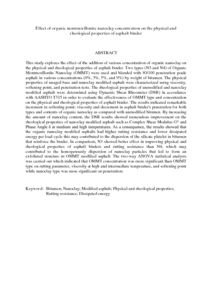Citation
Muniandy, Ratnasamy and Mahdi, Lamya M. J. and Yunus, Robiah and Hasham, Salihudin and Aburkaba, Eltaher Elzarroug
(2013)
Effect of organic montmorillonite nanoclay concentration on the physical and rheological properties of asphalt binder.
Australian Journal of Basic and Applied Sciences, 7 (9).
pp. 429-437.
ISSN 1991-8178
Abstract
This study explores the effect of the addition of various concentration of organic nanoclay on the physical and rheological properties of asphalt binder. Two types (N3 and N4) of Organic Montmorillonite Nanoclay (OMMT) were used and blended with 80/100 penetration grade asphalt in various concentrations (0%, 3%, 5%, and 9%) by weight of bitumen. The physical properties of unaged base and nanoclay modified asphalt were characterized using viscosity, softening point, and penetration tests. The rheological properties of unmodified and nanoclay modified asphalt were determined using Dynamic Shear Rheometer (DSR) in accordance with AASHTO T315 in order to evaluate the effectiveness of OMMT type and concentration on the physical and rheological properties of asphalt binder. The results indicated remarkable increment in softening point; viscosity and decrement in asphalt binder's penetration for both types and contents of organic nanoclay as compared with unmodified bitumen. By increasing the amount of nanoclay content, the DSR results showed tremendous improvement on the rheological properties of nanoclay modified asphalt such as Complex Shear Modulus G* and Phase Angle δ at medium and high temperatures. As a consequence, the results showed that the organic nanoclay modified asphalts had higher rutting resistance and lower dissipated energy per load cycle this may contributed to the dispersion of the silicate platelet in bitumen that reinforce the binder. In comparison, N3 showed better effect in improving physical and rheological properties of asphalt binders and rutting resistance than N4, which may contributed to the homogenously dispersion of nanoclay particles that led to form an exfoliated structure in OMMT modified asphalt. The two-way ANOVA statistical analysis was carried out which indicated that OMMT concentration was more significant than OMMT type on rutting parameter, viscosity at high and intermediate temperature, and softening point while nanoclay type was more significant on penetration.
Download File
![[img]](http://psasir.upm.edu.my/28699/1.hassmallThumbnailVersion/Effect%20of%20organic%20montmorillonite%20nanoclay%20concentration%20on%20the%20physical%20and%20rheological%20properties%20of%20asphalt%20binder.pdf)  Preview |
|
PDF (Abstract)
Effect of organic montmorillonite nanoclay concentration on the physical and rheological properties of asphalt binder.pdf
Download (186kB)
| Preview
|
|
Additional Metadata
| Item Type: |
Article
|
| Divisions: |
Faculty of Engineering |
| Publisher: |
American-Eurasian Network for Scientific Information |
| Keywords: |
Bitumen; Nanoclay; Modified asphalt; Physical and rheological properties; Rutting resistance; Dissipated energy |
| Depositing User: |
Nabilah Mustapa
|
| Date Deposited: |
05 Aug 2015 06:38 |
| Last Modified: |
07 Oct 2015 07:33 |
| URI: |
http://psasir.upm.edu.my/id/eprint/28699 |
| Statistic Details: |
View Download Statistic |
Actions (login required)
 |
View Item |

